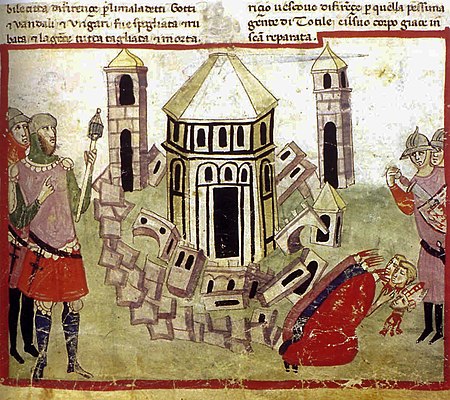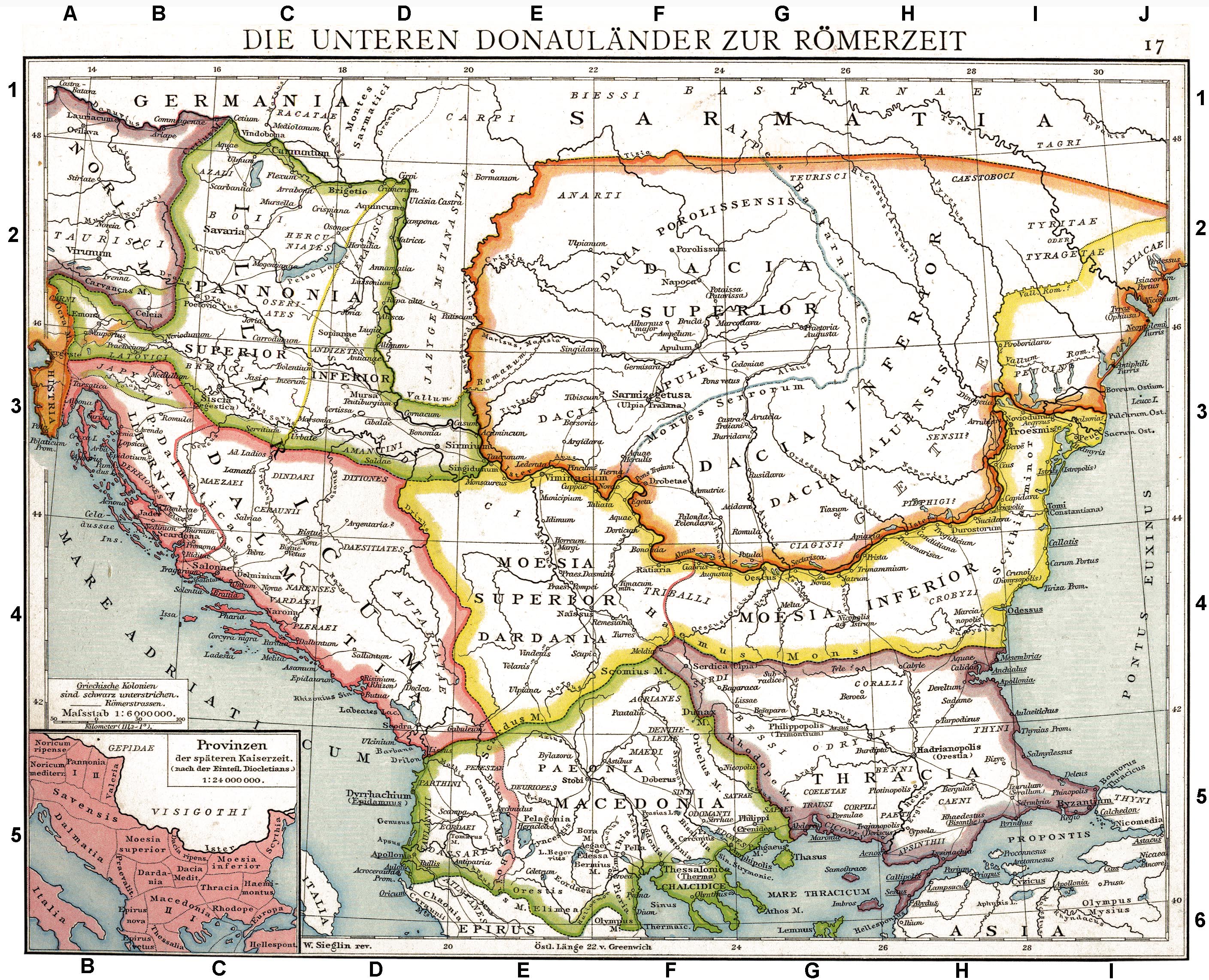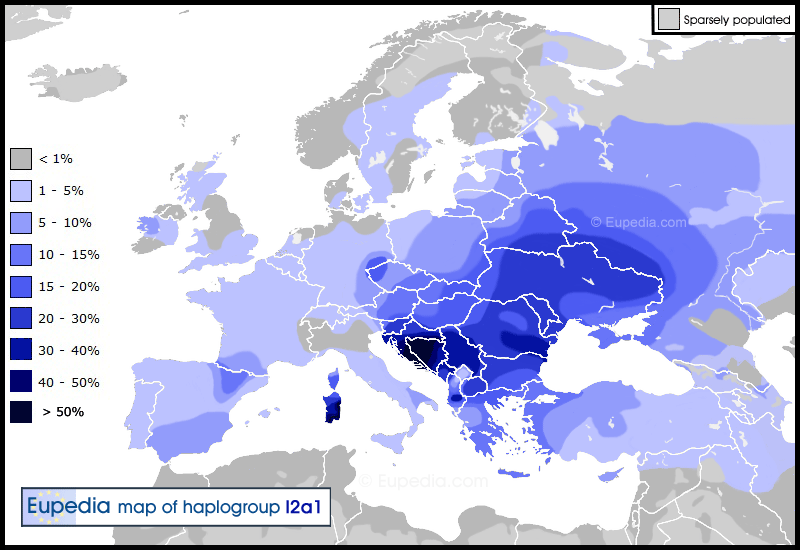So basically, you are saying that Goths took control of the Western Balkans after they had established Ostrogothic Kingdom (with which I agree). So today we have predominant I2a-Din in the Western Balkans as a consequence of that, but I2a-Din can be found in traces in Italy, even though the centre of their kingdom was in Italy?
I would say that this is ridiculous.
The Goths were never settled in Italy it was a military conquest, the homeland of these people was made in Pannonia. The Ostrogothic kingdom only lasted for 60 years as well so not much time for a lot of population drift especially in one of the most populated areas in Europe at that time.
Bosnia has a population of ~4 million , I2a1b frequency .55 = ~2.2 million
Croatia has a population of ~4 million, I2a1b frequency .37 = ~1.48 million
Italy has a population of ~60 million, I2a1 frequency about 3% but most of that is I2a1a, so frequency 1-2% = 600,000-1.2 million
If you look at the actual numbers it adds up, "trace frequencies" are misleading and sampling done is in its infancy. All that can be said for sure is that there is a lot of I2a1b in the Balkans, the most found in Pannonia/Dalmatia.
I've also posted a study earlier about a 9.4% frequency of I2a1 in Northern Italy(Trento), don't take Maciamo's maps as facts just very rough guesses.
If you want to know exactly why there is little in Italy and more in the northwestern Balkans, the Gothic conquest of Italy was never some genocide against the native inhabitants with the intention of resettlement of the Goths, it was a co-operative effort with the Eastern Roman Empire to re-assert Roman administration (which happened to fail miserably):
[h=3]Hunnic invasions[/h] The rise of the
Huns around 370 overwhelmed the Gothic kingdoms.
Many of the Goths migrated into Roman territory in the Balkans, while others remained north of the Danube under Hunnic rule. They became one of the many Hunnic vassals fighting in Europe, as in the
Battle of Chalons in 451. Several uprisings against the Huns were suppressed. The collapse of Hunnic power in the 450s led to further violent upheaval in the lands north of the Danube, during which most of the Goths resident in the area migrated to the Balkans. It was this group that became known as the Ostrogoths.
Gothic was still spoken sporadically in
Crimea as late as the 16th century: the
Crimean Gothic language.
[h=3]Post-Hunnic movements[/h] Their recorded history begins with their independence from the remains of the Hunnic Empire following the death of
Attila the Hun in 453. Allied with the former vassal and rival, the Gepids and the Ostrogoths led by
Theodemir broke the Hunnic power of Attila's sons in the
Battle of Nedao in 454.
The Ostrogoths now entered into relations with the Empire, and were settled on lands in Pannonia. During the greater part of the latter half of the 5th century, the East Goths played in south-eastern Europe nearly the same part that the West Goths played in the century before. They were seen going to and from, in every conceivable relation of friendship and enmity with the Eastern Roman power, until, just as the West Goths had done before them, they passed from the East to the West.
[h=3]Kingdom in Italy[/h] Main article:
Ostrogothic Kingdom


Map of Ostrogothic kingdom in Italy and the Balkans
The greatest of all Ostrogothic rulers, the future
Theoderic the Great (whose name means "leader of the people") of
Ostrogothic Kingdom, was born to
Theodemir in or about 454, soon after the Battle of Nedao. His childhood was spent at
Constantinople as a diplomatic
hostage,
[13] where he was carefully educated. The early part of his life was taken up with various disputes, intrigues and wars within the
Byzantine empire, in which he had as his rival
Theoderic Strabo, a distant relative of Theoderic the Great and son of Triarius. This older but lesser Theoderic seems to have been the chief, not the king, of that branch of the Ostrogoths that had settled within the Empire earlier. Theoderic the Great, as he is sometimes distinguished, was sometimes the friend, sometimes the enemy, of the Empire. In the former case he was clothed with various Roman titles and offices, as
patrician and
consul; but in all cases alike he remained the national Ostrogothic king. Theoderic is also known for his attainment of support from the
Catholic Church, which he gained by appeasing the
Pope in 520. During his reign, Theoderic, who was an
Arian, allowed freedom of religion, which had not been done before. However, he did try to appease the Pope and tried to keep his alliance with the church strong. He saw the Pope as an authority not only in the church but also over Rome.
Theoderic sought to revive Roman culture and government and in doing so, profited the Italian people.[14] It was in both characters together that he set out in 488, by commission from the Byzantine emperor Zeno, to recover Italy from Odoacer. By 493 Ravenna was taken, where Theoderic would set up his capital. It was also at this time that Odoacer was killed by Theoderic's own hand. Ostrogothic power was fully established over Italy, Sicily, Dalmatia and the lands to the north of Italy. In this war
[which?] the Ostrogoths and Visigoths began again to unite, if we may accept the witness of one writer
[citation needed] that Theoderic was helped by Visigothic auxiliaries. The two branches of the nation were soon brought much more closely together; after he was forced to become regent of the Visigothic kingdom of
Toulouse, the power of Theoderic was practically extended over a large part of
Gaul and over nearly the whole of the
Iberian peninsula. Theoderic also attempted to forge an alliance with the Frankish and Burgundian kingdoms by means of a series of diplomatic marriages. This strengthening of power eventually led the Byzantine emperor to fear that Theoderic would become too strong, and motivated his subsequent alliance with the Frankish king,
Clovis I, to counter and ultimately overthrow the Ostrogoths.


The mausoleum of
Theoderic the Great in
Ravenna
A time of confusion followed the death of
Alaric II, the son-in-law of Theoderic, at the
Battle of Vouillé. The Ostrogothic king stepped in as the guardian of his grandson
Amalaric, and preserved for him all his Iberian and a fragment of his Gaul dominion. Toulouse passed to the
Franks but the Goth kept
Narbonne and its district and
Septimania, which was the last part of Gaul held by the Goths and kept the name of Gothia for many ages. While Theoderic lived, the Visigothic kingdom was practically united to his own dominion. He seems also to have claimed a kind of protectorate over the
Germanic powers generally, and indeed to have practically exercised it, except in the case of the
Franks.
The Ostrogothic dominion was now again as great in extent as and far more splendid than it could have been in the time of
Hermanaric; however it was now of a wholly different character. The dominion of Theoderic was not a
barbarian but a
civilized power. His twofold position ran through everything. He was at once national king of the Goths, and successor, though without any imperial titles, of the West
Roman emperors. The two nations, differing in manners, language and religion, lived side by side on the soil of Italy; each was ruled according to its own law, by the prince who was, in his two separate characters, the common sovereign of both.
The picture of Theoderic's rule is drawn for us in the state papers drawn up, in his name and in the names of his successors, by his Roman minister
Cassiodorus. The Goths seem to have been thick on the ground in northern Italy; in the south they formed little more than garrisons. In Theoderic's theory the Goth was the armed protector of the peaceful Roman; the Gothic king had the toil of government, while the Roman consul had the honour. All the forms of the Roman administration went on, and the Roman policy and culture had great influence on the Goths themselves. The rule of the prince over distinct nations in the same land was necessarily despotic; the old Germanic freedom was necessarily lost. Such a system needed a Theoderic to carry it on. It broke in pieces after his death.
[h=3]War with Rome (535–554)[/h] Main article:
Gothic War (535–554)


Coin of
Theodahad (534-536), minted in
Rome. He wears the barbaric
moustache.
Upon the death of Theoderic in 526 the Ostrogoths and Visigoths were again separated. The few instances where they act together after this time are as scattered and incidental as they were before. Amalaric succeeded to the Visigothic kingdom in Iberia and Septimania.
Provence was added to the dominion of the new Ostrogothic king
Athalaric, the grandson of Theoderic through his daughter
Amalasuntha. Both were unable to settle disputes among Gothic elites.
Theodahad, cousin of Amalasuntha and nephew of Theoderic through his sister, took over and slew them; however the usurping ushered in more bloodshed. Three more rulers stepped in during the next five years.
The weakness of the Ostrogothic position in Italy now showed itself. The Eastern Roman Emperor
Justinian I always strove to restore as much of the Western Roman Empire as he could and certainly would not pass up the opportunity. In 535, he commissioned
Belisarius to attack the Ostrogoths. Belisarius quickly captured Sicily and then crossed into Italy where he captured Naples and Rome in 536 and then marched north, taking Mediolanum (
Milan) and the Ostrogoth capital of Ravenna in 540.
At this point Justinian offered the Goths a generous settlement—too generous by far in Belisarius' eyes—the right to keep an independent kingdom in the Northwest of Italy, and the demand that they merely give
half of all their treasure to the Empire. Belisarius conveyed the message to the Goths, although he himself withheld from endorsing it. They, on the other hand felt there must be a snare somewhere. The Goths did not trust Justinian, but because Belisarius had been so well-mannered in his conquest they trusted him a little more, and agreed to take the settlement only if Belisarius endorsed it. This condition made for something of an impasse.


Totila razes the walls of
Florence: illumination from the Chigi ms of
Villani's Cronica.
A faction of the Gothic nobility pointed out that their own king
Witiges, who had just lost, was something of a weakling and they would need a new one.
Eraric, the leader of the group, endorsed Belisarius and the rest of the kingdom agreed, so they offered him their crown. Belisarius was a soldier, not a statesman, and still loyal to Justinian. He made as if to accept the offer, rode to Ravenna to be crowned, and promptly arrested the leaders of the Goths and reclaimed their entire kingdom—no halfway settlements—for the Empire.
This upset Justinian greatly: the
Persians had been attacking in the east, and he wanted a stable neutral country separating his western border from the Franks, who weren't so friendly. Belisarius was sent to face the Persians and therefore left John, a Byzantine officer, to govern Italy temporarily.
In 545 Belisarius returned to Italy, where he found the situation had changed greatly. Eraric was slain and the pro-Roman faction of Gothic elite had been toppled. In 541 the Ostrogoths had elected a new leader
Totila; this Goth nationalist and brilliant commander had recaptured all of northern Italy and even driven the Byzantines out of Rome. Belisarius took the offensive, tricked Totila into yielding Rome along the way, but then lost it again after a jealous Justinian, fearful of Belisarius' power, starved him of supplies and reinforcements. Belisarius was forced to go on the defensive, and in 548, Justinian relieved him in favor of the
eunuch general Narses, of whom he was more trustful.
Totila was slain in the
Battle of Taginae in July 552 and his followers
Teia,
Aligern, Scipuar, and Gibal were all killed or surrendered in the
Battle of Mons Lactarius in October 552 or 553.
Widin, the last attested member of the Gothic army revolted in late 550s, with minimal military help from the Franks. His uprising was fruitless; the revolt ended with Widin captured and brought to Constantinople for punishment in 561 or 562.
With that final defeat, the remaining Ostrogoths went back north and (re)settled in south Austria. The Ostrogothic name wholly died. The nation had practically evaporated with Theoderic's death. "The leadership of western Europe therefore passed by default to the Franks. Consequently, Ostrogothic failure and Frankish success were crucial for the development of early medieval Europe", for Theoderic had made it "his intention to restore the vigor of Roman government and Roman culture".
[15] The chance of forming a national state in Italy by the union of Roman and Germanic elements, such as those that arose in Gaul, in Iberia, and in parts of Italy under Lombard rule, was thus lost. As a result the Goths hold a different place in Iberian memory than in Italian memory: In Italy, the Ostrogoths were a momentary invader and ruler, while in Iberia the
Visigoths supplied an important element in the founding of that nation, a fact that has been neither forgotten nor despised. Part of the unconquered region of northern Iberia, the land of
Asturias, kept for a while the name of Gothia, as did the Gothic possessions in Gaul.









